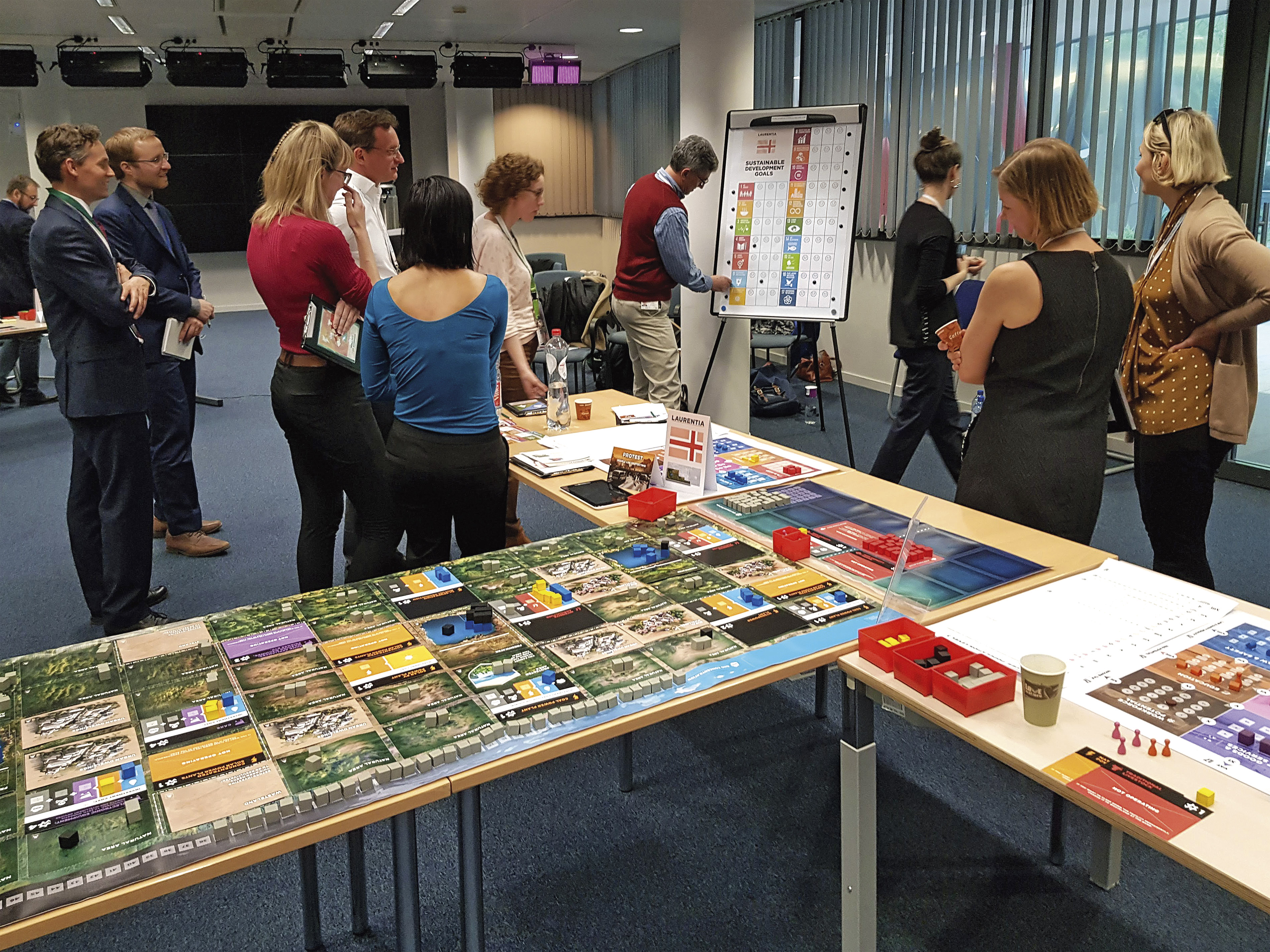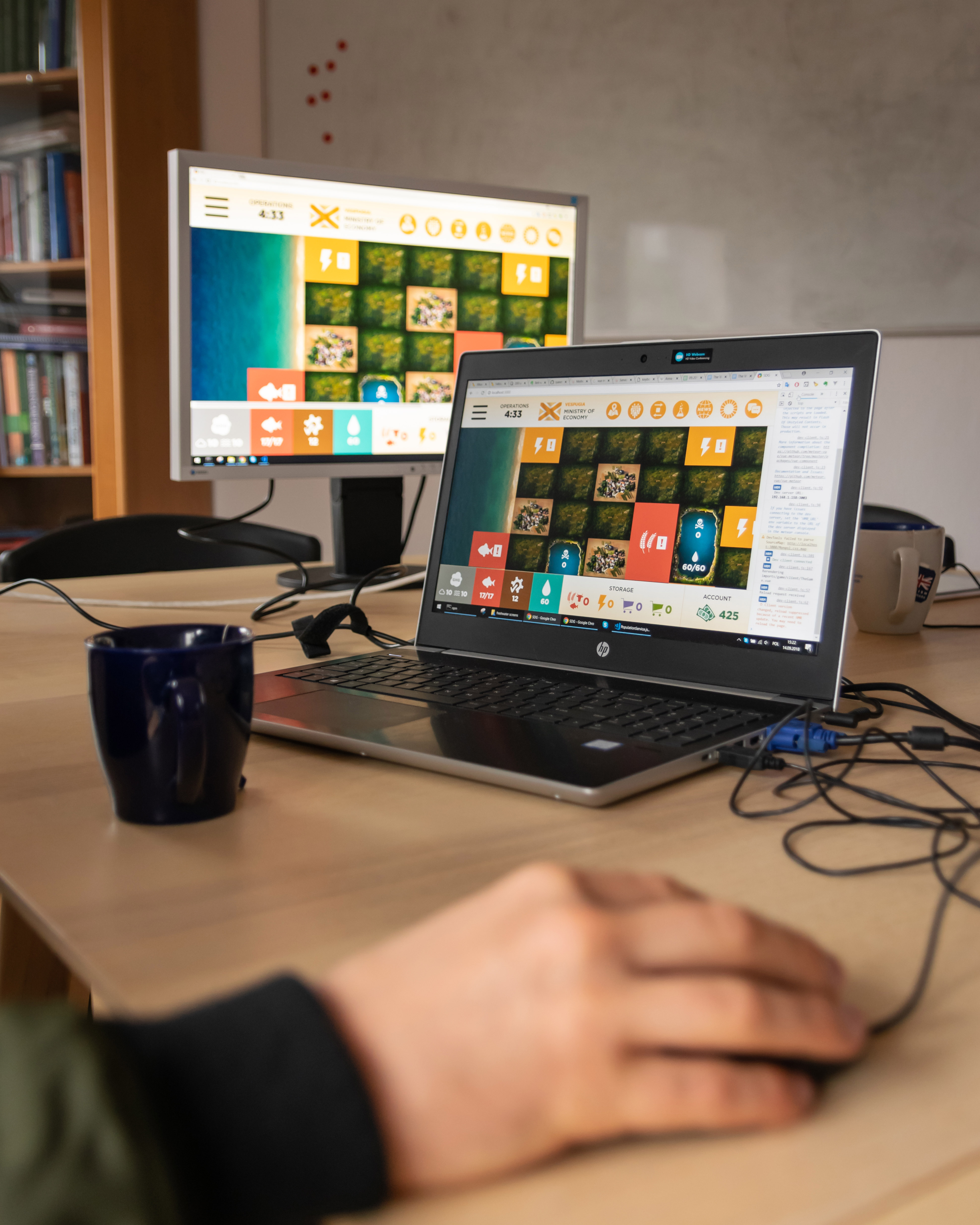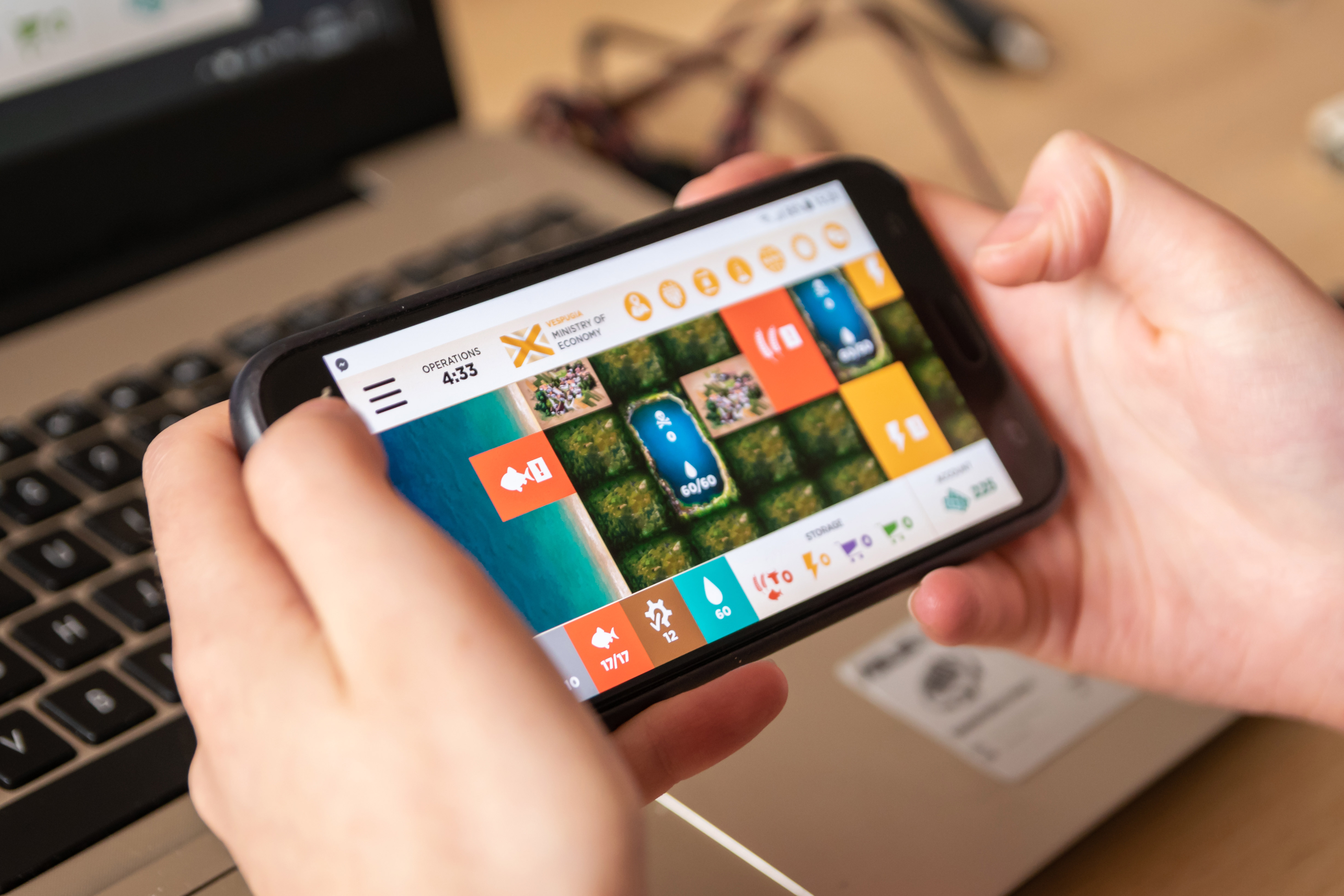The World’s Future – A Sustainable Development Goals Game that highlights the interlinkages among the SDGs and targets
Description
The World’s Future – A Sustainable Development Goals Game was developed in 2016 to bridge a gap between knowledge about the SDGs and practical implementation of solutions that may accelerate their achievement. It is an immersive social simulation, that is, a multiplayer serious game that combines entertaining informational elements with the lively dynamics of social interaction to provide a transformative learning experience about the interconnections between the SDGs. In opposition to the traditional textbook- or lecture-based techniques, it is fully experiential, interactive and enables participants to face potential trade-offs and synergies among different goals and targets to explore optimal solutions.
The main objective behind The World’s Future (TWF) is to help people gain a systems perspective on the SDGs and see how they are interrelated. Thus, although the simulation provides the opportunity to explore and address all the Goals described in the 2030 Agenda, it is foremost focused on promoting Goal 17, Partnership for the Goals, understood not only as Target 17.16, knowledge and expertise sharing or Target 17.17, encouraging public, public-private and society partnership, but especially as Target 17.14 - enhancing policy coherence for sustainable development. How? Far too often, policymakers address a specific goal as something separate from other SDGs; something that can be tackled in a linear way, in silos, by a single department or industry sector. Meanwhile, one of the biggest challenges in addressing the 2030 Agenda is the realization that even the best solutions for certain goals may have negative impacts on others. To address this, we must develop strong intersectoral and international cooperation and acknowledge the existing interrelations between the SDGs. Only an approach which realizes the benefits of synergistic actions and mitigates unavoidable trade-offs can ensure that all needs are being equally addressed, and “no one is left behind.”<br />
<br />
But how to gain a systems perspective on 17 goals and 150+ indicators without being able to know the externalities of your potential decisions? We chose the social simulation approach, as its strength lies in its ability to mirror real life. By selecting and extracting key challenges related to the successful implementation of the SDGs, a simplified model of a complex global landscape was created. The World’s Future simulation serves as a sandbox to help people safely explore a number of future scenarios without leaving the present. <br />
<br />
In TWF, participants become country leaders and collaboratively steer the fictional world from now till around 2050. Role cards, boards, and tokens symbolically represent social relationships and possible actions. Moreover, as players make decisions about their country’s energy mix, R&D expenditures, environmental policy, and socio-economic growth, their successes and failures are monitored every round. Consequently, participants get a very realistic feel of what may happen if we don’t accelerate energy transformation, address climate change, or change our production and consumption trends. In a safe environment, they can learn from mistakes and take corrective action. Moreover, adopting roles helps players understand issues from other perspectives, triggering the empathy and understanding that are foundational to reaching consensus.<br />
<br />
The initial design challenges centred on selecting an appropriate scale of information to incorporate, creating a model, and designing a process for conveying it in a way that would engage users in sharing and testing their knowledge, values and perspectives. The first version of the simulation was much too complex, with participants experiencing information overload. It needed many user-tests and iterations to reach its final shape. However, as shown in further parts of the proposal, it is now fully operational and appreciated by players.
The project was initiated in late 2016/early 2017 as part of an IIASA research project, Systems Thinking for Transformation, focused on promoting systems thinking as an essential 21st-century skill both among the general public and the specific target groups (young people, future policy- and decision-makers).
From the very beginning, we wanted to create a tool that would render the complexity of Global Goals into a more easily digestible form. Our aim was to promote a systems perspective on global challenges and increase the general awareness of their interconnected nature. We also wanted to lead a participatory, feedback-driven design process so that the tool would be something that educators, teachers and researchers would be able to use to engage their audience in discovering the challenges and opportunities arising from the pursuit of the SDGs. Therefore, we based our monitoring mechanism on frequent user-tests, feedback sessions and/or surveys, followed by new simulation iterations.
The first test, led in Vienna 2017 with members of the Bundes Jugend Vertretung, proved that the simulation’s mechanics were too complex. Participants had difficulties embracing the complicated net of interrelations between roles, actions and consequences. Further tests and feedback from other users helped us simplify the simulation, reduce the number of elements, and improve its mechanics, while still maintaining the game’s main lessons about the SDGs. Currently, the simulation is widely used to raise awareness of global threats (in particular, climate change and its related impacts on the environment, society and economy, energy transition, social inequalities, and corporate social responsibility) and relevant, coherent policies to address them. On each occasion, we ask participants to fill in a survey, collecting their insights and comments that help us monitor their progress in understanding the SDGs.
So far we have led more than a dozen workshops in several European countries with policy-makers, researchers and sustainability experts, educators and students, including members of the European External Action Service (Belgium), the Research Institute of Organic Agriculture (Switzerland) and students from University of Koblenz-Landau (Germany). The tool has been used to trigger discussion on optimal strategies for achieving the SDGs at many European events and conferences, including IIASA’s SDG Lab 2017, the OECD Policy Coherence for Sustainable Development initiative, the European Forum Alpbach 2017, or the “Away Day” for the employees of Directorate-General for International Cooperation and Development (DG DEVCO).
Recently, TWF has attracted the attention of Climate-KIC, Europe's largest public-private innovation partnership focused on climate innovation to mitigate and adapt to climate change. In February and April 2019, the online version of the simulation will be used by them in an intensive online course, Teaching sustainability - Using simulation to reach the SDGs in regional transformation. This three-day online course is targeted at equipping educators and other transformation leaders with know-how on how to actively engage a general audience in taking responsibility for our common future.
Moreover, players often notice that the simulation highlights the importance of strong partnership for SDGs (this feature was mentioned more than 20 times and was often referred to by players also as teamwork, collaboration, cooperation, shared understanding, shared interest, communication, dialogue). As stated by one of the players, the simulation teaches that “...Isolated action is not very useful. In order to effectively work, there is a need to cooperate with all relevant stakeholders.”
Players also appreciate the fact that TWF displays the need of “a clear structure for coherent decision- making” where an emphasis is put on strong leadership, coordination, consultation, setting rules and prioritizing actions (these words appeared more than 30 times in the surveys).
Interestingly enough, although some players treat “integrated approach” or “cooperation” as something obvious in policy-making, they don’t always know how to render it into practice. Meanwhile, the simulation forces them to struggle with a situation where “time is limited, resources are not indefinite, and every decision has some negative consequences” (one of the participants of the simulation sessions for the members of the European External Action Service in Belgium). In this way, they may experience firsthand how difficult it is to reach consensus and address conflicting needs of different stakeholders. As one of the representatives of the European External Action Service after a TWF session in April 2018 said: “I've long been interested in sustainability, yet this game has strengthened my sense that international cooperation is essential to meet the SDGs!” Such comments may just prove that even conscientious people; policy-makers, scientists, and researchers need to be reminded of these fundamental truths. And what about others, in particular, less privileged people with little access to information and knowledge? We don’t want to leave anyone behind. We believe that TWF simulation will help us spread the word about the importance of an integrated approach to and global cooperation for SDGs even in the most remote parts of the world.
Furthermore, as proved by users’ feedback, this type of participatory and immersive game-based approach to knowledge sharing is very attractive for general audiences. Players praise it for its ability to reveal the real world’s complexity without them being forced to sit and listen to a lecture or presentation full of complicated diagrams and abstract facts. Instead, social simulations rely on what was referred to as procedural rhetoric by Ian Bogost— games’ design that is aimed at creating spaces mimicking real-world situations and challenges—that can be actively explored by players. What does it mean? It means that at every stage of TWF players are meaningfully engaged in something that could be compared to creative group scenario building or role-playing, where they have the opportunity to confront people of different backgrounds and worldviews, learn to solve conflicts and negotiate or empathise with each other. Through the use of symbolic representations, roles, problem cards, tokens, players can actively discover the interrelations between different SDGs, establish in-game allies and partnerships and “play out” possible scenarios for the implementation of the 2030 Agenda. And all this happens via the game’s embedded design relying upon active problem-solving and emotional engagement rather than on direct persuasion or moralizing.
TWF offers thus a playful yet transformative experience that is rooted in and based on one of the most characteristic elements of social life - drama. According to Victor Turner, social dramas are social processes occurring within groups bounded by shared values and interests of having a common history. Social dramas necessarily entail conflict or breach that reveals the underlying differences in values or perspectives within a group, and - through an inevitable crisis and redress mechanisms - lead either to reintegration of the disturbed social group or schism. In each scenario, the resulting social reconciliation or separation brings about a noticeable transformation of values, influences or social relationships. Similarly, social simulations, entailing various participants and engaging them in joint pursuit of the SDGs, creates many learning opportunities, triggering self-reflection and independent critical thinking. Therefore, we believe that the practice may not only promote Partnership for SDGs but foremost offer a new perspective on education on and dissemination of sustainability, which is based on personal engagement and active problem-solving.
In relation to the analogue version of the simulation, it will soon be ready for self-print and arrangement. The game elements (boards, role descriptions, cards, etc.) will be freely downloadable and a comprehensive user guide will be provided on how to print them and arrange them on the table. Such a guide is especially useful, as in the existing form, the game consists of more than 300 elements necessary to conduct a successful game session. The guide will be available in English, enabling potential users across Europe (and across the globe) to replicate its success and lead game sessions themselves. In addition to that, our offer includes user-tailored moderator trainings, both in-person and online.
In relation to the online version, a set of video tutorials and webinars for moderators is being prepared in connection with the Climate-KIC course. However, after the conclusion of the course, we will also offer individual moderator trainings. Access to the online simulation is and will be free of charge for non-commercial uses to enable as many people as possible to use it freely in their contexts.
The World’s Future is an ongoing project that we plan to apply as long as relevant (at least until 2030). Each session brings more insights into and reflections on how important it is to make people realize that we are all responsible for what becomes our future. We are happy to read players’ feedback and learn that the simulation “… translates a lot of knowledge and, in this particular case, threats into quite lively experiences. These last much longer in the minds of the players than the same information in the form of books.” It also enhances personal engagement, and “… by this, a better understanding of processes and how complexity and uncertainty may influence decisions.” We hope that by 2030 we will be able to tell you even more success stories and the impact we all made will be best reflected in the condition of our planet.
The World’s Future platform, from which it can be accessed, moderated and played: https://play.socialsimulations.org/
An article about The World’s Future: https://socialsimulations.org/articles/worlds-future-in-our-hands/
An article about social simulations: https://socialsimulations.org/navigate-through-complexity/
A lecture on social simulations as a tool for awareness raising and navigating complex problems:
Part 1: https://www.youtube.com/watch?v=gKCMmRkbj6c
Part 2: https://www.youtube.com/watch?v=up9vqyuEk1I
Part 3: https://www.youtube.com/watch?v=V54b14MChEw
Part 4: https://www.youtube.com/watch?v=trjlC75FjJY
Part 5: https://www.youtube.com/watch?v=pOM9epW1P6U
SDGS & Targets
Deliverables & Timeline
Resources mobilized
Partnership Progress
| Name | Description |
|---|---|
| 17.14 | Enhance policy coherence for sustainable development |
Feedback
Action Network


Timeline
Entity
Region
- Europe
Geographical coverage
Photos



Website/More information
Countries

Contact Information
Aleksandra Solinska-Nowak, Mrs
